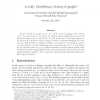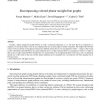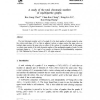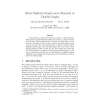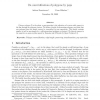CORR
2010
Springer
13 years 2 months ago
2010
Springer
Let G = (V, E) be a graph. Let c : V → N be a vertex-coloring of the vertices of G. For any vertex u, we denote by N[u] its closed neighborhood (u and its adjacent vertices), an...
CORR
2010
Springer
13 years 3 months ago
2010
Springer
A graph G is (a, b)-choosable if for any color list of size a associated with each vertices, one can choose a subset of b colors such that adjacent vertices are colored with disjoi...
COMGEO
2008
ACM
13 years 3 months ago
2008
ACM
Consider a planar straight line graph (PSLG), G, with k connected components, k 2. We show that if no component is a singleton, we can always find a vertex in one component that s...
DM
1998
13 years 4 months ago
1998
The total chromatic number zt(G) of a graph G is the least number of colors needed to color the vertices and edges of G so that no adjacent vertices or edges receive the same colo...
DAM
2002
13 years 4 months ago
2002
A block graph is a graph whose blocks are cliques. A block duplicate (BD) graph is a graph obtained by adding true twins (i.e., adjacent vertices with the same closed neighborhood...
GC
2007
Springer
13 years 4 months ago
2007
Springer
A clique is a set of pairwise adjacent vertices in a graph. We determine the maximum number of cliques in a graph for the following graph classes: (1) graphs with n vertices and m ...
DM
2006
13 years 4 months ago
2006
An L(h, k)-labeling of a graph G is an integer labeling of vertices of G, such that adjacent vertices have labels which differ by at least h, and vertices at distance two have lab...
DM
2008
13 years 4 months ago
2008
A (p, 1)-total labelling of a graph G is an assignment of integers to V (G) E(G) such that: (i) any two adjacent vertices of G receive distinct integers, (ii) any two adjacent ed...
DM
2010
13 years 4 months ago
2010
Given a polygon P in the plane, a pop operation is the reflection of a vertex with respect to the line through its adjacent vertices. We define a family of alternating polygons, a...
DM
2010
13 years 4 months ago
2010
The chromatic capacity of a graph G; CAP (G) ; is the largest integer k such that there is a k-colouring of the edges of G such that when the vertices of G are coloured with the s...
